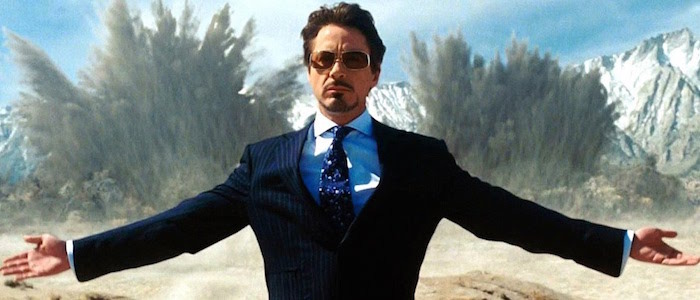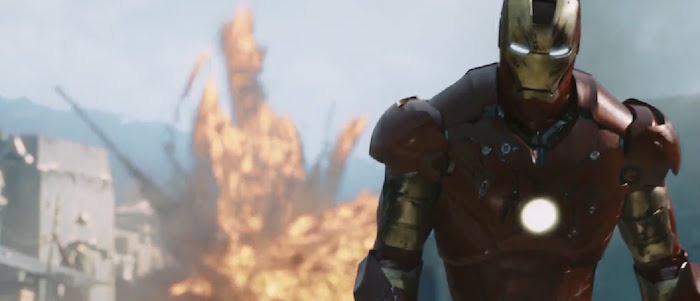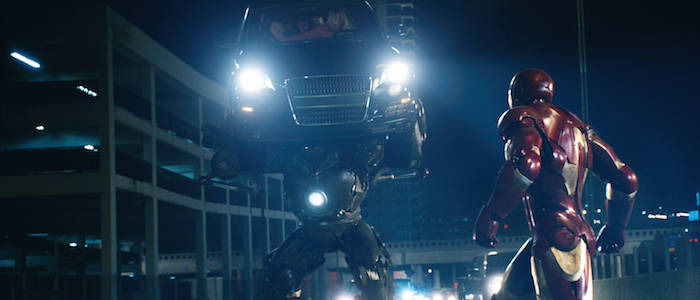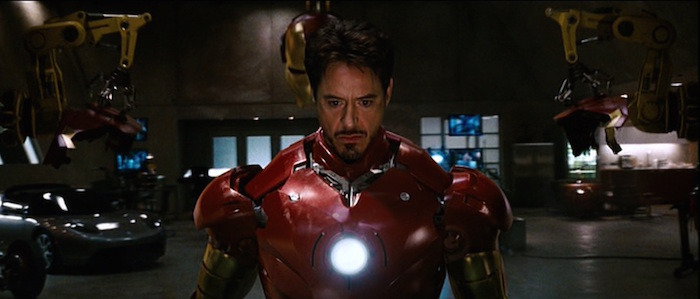How 'Iron Man' Built The Foundation Of The Marvel Cinematic Universe
(Welcome to Road to Infinity War, a new series where we revisit the first 18 movies of the Marvel Cinematic Universe and ask "How did we get here?" First up: Iron Man, and how Marvel turned a series of flaws into profound strengths.)
The Marvel machine went into production without a completed script. A few years prior to Disney purchasing the House of Ideas, director Jon Favreau and then newly named President of Production Kevin Feige began laying track in front of train on Marvel's first in-house feature – or as co-star Jeff Bridges described it, a "$200 million student film." Unlike any other movie at the time, Iron Man also had to open up a whole new world of characters yet unseen, scribbling just outside its own margins in order to make good on Feige's promise of an entire Avengers universe at Comic Con 2006.
How did it go? Well, the year is 2018, and we're waiting (im)patiently for Iron Man to charge into cosmic battle alongside the Avengers, the Guardians of the Galaxy, Spider-Man, Doctor Strange, and all of Wakanda in a few weeks' time. Not only have the aforementioned characters become mainstays of global popular culture, the Marvel Cinematic Universe has also long since become the highest grossing film franchise in human history. Quite a return on investment for a student film.
A Stark Difference
Marvel wouldn't be where it is without Iron Man, a character who shattered the cookie-cutter superhero mythology by revealing himself to the world out of pure ego, but it certainly wouldn't have gotten here without Robert Downey Jr.'s Iron Man specifically. The character felt like a dare to begin with, with Stan Lee creating something of an antithesis to the youth movements of 1968, turning a capitalist, industrialist, and weapons manufacturer into a likeable fixture of Marvel Comics. 40 years later, Tony Stark's first film appearance would come into being thanks to a similar creative stubbornness, as Jon Favreau fought all opposition in order to get Downey Jr. into the CGI-augmented red & gold.
An actor whose own past addictions would no doubt prepare him for the role in the long run – though the character's trademark alcoholism would be swapped out for a PTSD-induced addiction to cocooning himself in titanium come Iron Man 3 – what made Robert Downey Jr. the perfect Patient Zero for Marvel's experiment was his unique ability as a storyteller. Not only was much of his dialogue improvised on set (the lack of a solid script allowed him to step further into Stark's expensive shoes), but Downey Jr. was forged into the MCU's early secret weapon, bringing to the action genre an oft-overlooked talent: the ability to turn even rote exposition into development of character – be it with a look, a smirk, or the disguising of insecurity under layers of sardonic quips.
Right from the opening scene, as Stark rides alongside American soldiers in their Humvee in Afghanistan, his aura simultaneously attracts and alienates. He has the shine of a billionaire playboy and a detached allure that arrived just in time for the social media boom – the age of irony, as it were – but his humour is to-the-point despite the emptiness it masks. From the get-go, long before he builds his rudimentary Mark I suit, his first layer of armour is exactly the person he projects himself to be. The epitome of untouchable, yet commanding a gravity that attracts everyone in its oribit.
It's fitting then, that this introduction to a superhero so out of the ordinary is soon followed by a seemingly real-world attack and circumstance that cuts him down to size. The unit protecting him is bombed. He is kidnapped by militants. And he becomes a victim of weapons that bear his own name, although his key change as a character comes about as a similarly kidnapped small-town scientist from the Middle East uses technology in a way Stark had seldom considered. He builds something new to save Tony Stark's life.
Fantasy Hero, Political Reality
2008 was a landmark year for politics in superhero movies. While The Dark Knight, a film that at the time seemed like it would have a more long-lasting impact, wrestled with abstract questions of the borders of responsibility in the face of national security, Iron Man had far more direct questions on its mind. Shifting the setting of the character's origin from '60s Vietnam to modern Afghanistan allowed for literal articulations of modern American military industrial complex to arrive front-and-center, as embodied not by the film's villain, but its hero.
The reason Stark visits the Middle East is to sell deadly weapons to the U.S. military, weapons he openly compares to the Manhattan project his father worked on decades earlier. Charming as he may be, his outlook is detestable, and he's forced to face up to it (to some degree) once he's kidnapped and he sees where all his missiles are actually being shipped. "Peace means having a bigger stick than the other guy," he tells a reporter, who rightly responds: "That's a great line, coming from the guy selling the sticks."
Iron Man is, at its core, a tale of an American war profiteer having a change of heart – represented by the arc reactor in his chest, a glowing promise of untold possibility. It's a potent idea, focusing on a character who sees his weapons fall into the wrong hands and takes action accordingly, contending with his own legacy by shutting down the weapons' division of Stark Industries, but therein lies the central problem of Tony Stark. While he works to get his weapons out of said wrong hands, be it the hands of the Ten Rings organization or the hands of Jeff Bridges' Obadiah Stane, the man behind the curtain (to say nothing of the hands of the US military, to whom Stark was more than happy to sell thus far), there's nothing clearly delineating whose hands are the right ones. To Tony Stark, the egocentric futurist, the right hands remain his own.
The Failure to Overcome
A film cannot be all things at once, especially if it's a product of the American studio system. Its first obligation is often towards the machinery that allowed it to be, and so Iron Man's second half is littered with what one might to refer to as "trailer moments," the kind used to sell toys and tickets. It's a distinction by no means unique to Iron Man or even to the Marvel universe, but the way in which the action often undercuts the story is a complaint common enough that even diehard Marvel fanboys would have to admit its validity. The film's final battle, albeit one between Iron Man and simply "bigger Iron Man" (the comics' Iron Monger) is an attempt to contrast Stark's newfound sense of righteousness with the warmonger he once was and may become once more if he isn't careful, but it still pits two titans of weapons technology, Stark and Stane, against one another for ideological control of how these new weapons ought to be utilized.
We know how Obadiah Stane would use them, the same way he'd been using all weaponry thus far, but the film doesn't seem to give Stark a clear answer. If anything, his destruction of newly shipped Stark Industries weapons to Middle Eastern militia feels distinctly at odds with his newfound outlook. It's an outlook that, while anti-militarism in texture and dialogue, still sees him employing distinctly US military tactics of unsanctioned foreign intervention, putting civilians at further risk in the process – an act that isn't ever contextualized as anything but purely heroic.
Which isn't to say these disconnects in ideology and modus operandi kneecap the entire film – it remains one of the most potent and re-watchable MCU entries even a decade later – but they do inadvertently place the blame of military industrial complex wholly on industry, ignoring the actual military element in the process. The US military's role in the film's foreign policy backdrop is glaring omission, with American proxy wars contextualized as a product of private capitalism as opposed to any government involvement whatsoever, an unfortunate choice regardless of its reasoning given the film's otherwise direct articulations of what militarism looks like on the surface.
The biggest effect this ends up having however, is not on the plot of the film itself, but on the character of Tony Stark. He's given enough reason to hold only his own company accountable, but not the various forces that are undoubtedly related to Stark Industries, leading to a lack of self-awareness on Stark's behalf with regards to his newfound sense of responsibility. However, this lack of contextualization ends up being a surprisingly solid foundation for the Marvel universe regardless, despite it arguably being a failure for this film in particular.
The Long Game
It's been 10 years since Iron Man arrived in theaters. Viewing the film as a single entry reveals both unprecedented articulation of political perspective in the superhero "genre" as well as a failure of the specifics those very politics. However, when viewed in continuum, it makes complete sense for the character Tony Stark has come to be. As we'll go on to discuss in the coming weeks, Iron Man 2, Iron Man 3, both Avengers entries, Captain America: Civil War and even Spider-Man: Homecoming build on this thread of Stark as a problem solver who creates new problems with every issue he solves, turning this first film's central flaw into a narrative opportunity for course correction. Come Civil War eight years and four appearances later, Stark is the one arguing against the very methods he employed in this first appearance.
Iron Man sees Tony Stark, and the Marvel universe at large, identifying a problem but failing to provide a concrete solution. But in the process, the series sets up what is perhaps one of modern pop culture's most fascinating long-term narratives, one that sees Stark (as well as his teammate and eventual rival, Captain America) struggle to find satisfying answers to the problems of power and responsibility that plague the modern world on a geopolitical scale. There may be no simple solutions at all.
Instead, the series wrestles with these ideas of militarism and intervention in increasingly complex iterations, and in ways that shift in focus as the characters themselves undergo changes in perspective. The Tony Stark of Iron Man is not the Tony Stark of Avengers: Infinity War, but the decade in between sees a wide array of evolutions in outlook, scope and style that make this vast difference feel like a singular journey, cobbled together from seemingly disparate franchises. A flaw turned into narrative gold, with Marvel keeping viewers invested as the world at large wrestles with these very same ideas ad infinitum, dominating the global cinematic landscape in the process.
And it all began without a completed script.




